How Does Public Sentiment Affect the Socially Responsible Behavior of Construction Enterprises?
Abstract
1. Introduction
- (1)
- (2)
- (3)
- This paper discusses the mechanisms of heterogeneous emotions and their emotional combinations regarding decision making, and relevant suggestions are made which are expected to provide effective technical and theoretical support to promote the level of social responsibility practiced by construction enterprises.
2. Game Model Construction
2.1. Problem Description
2.2. Model Assumptions
2.3. Model Construction
2.3.1. Traditional Game Model
2.3.2. Rank-Dependent Expected Utility Model
- (1)
- When , is a concave function, for any , narrows the possibility of , indicating the pessimism of the participants;
- (2)
- When , is a convex function, for any , widens the possibility of , indicating the optimistic mood of the participant;
- (3)
- When , the possible is unchanged. there is no emotion affecting the participant’s strategy, that is, the rational emotions among the participants.
- (1)
- strategy stability analysis of construction enterprises
- (2)
- public strategy stability analysis
3. Game Analysis
3.1. Scenario 1: The Construction Enterprise Is Rational, and the Public Is Rational
3.2. Scenario 2: The Construction Enterprise Is Emotional, and the Public Is Emotional
3.3. Scenario 3: The Construction Enterprise Is Rational, and the Public Is Emotional
3.4. Scenario 4: The Construction Enterprises Is Emotional, and the Public Is Rational
4. Simulation Analysis
4.1. (Rational, Rational) State Analysis, That Is
4.2. (Optimistic, Rational) State Analysis, That Is
4.3. (Pessimistic, Pessimistic) State Analysis, That Is
4.4. (Optimistic, Pessimistic) State Analysis, That Is
4.5. (Pessimistic, Optimistic) State Analysis, That Is
4.6. (Optimistic, Rational) State Analysis, That Is
4.7. (Pessimistic, Rational) State Analysis, That Is
4.8. (Rational, Optimistic) State Analysis, That Is
4.9. (Rational, Pessimistic) State Analysis, That Is
5. Conclusions
5.1. Research Findings
- (1)
- There is probability in the choice of a rational strategy, and strategy choice is influenced by the irrational factor of emotion. When emotional fluctuations are considered during investigating the strategy selection of game subjects, rational equilibrium strategies become probabilistic events. Perceptual bias, as well as psychological fallout, are extremely likely to cause players to misjudge the status quo and their opponent’s expected behavior, thus influencing the ultimate choice outcome.
- (2)
- Emotional intensity and emotional tendency will change the evolutionary trend of game subject strategy selection. For construction enterprises, optimism will always amplify the public’s understanding and tolerance of malpractices and generate perception bias, thus ignoring the possible negative impact of the current state of social responsibility fulfillment and restricting their social responsibility practice behavior. This finding differs from those in previous research, showing that “optimism leads to excellent outcomes” is conditional [50], and optimism can moderately increase the probability of decision makers choosing positive strategies [66]. This further demonstrates the uniqueness of the construction industry and the deeper reasons for the lack of social responsibility in this industry. For the public, pessimism promotes the probability of choosing their negative strategies, whereas rational and optimistic states avoid contradictory and aggravated behaviors and show a positive tendency to choose response strategies. In addition, variations in the strength of emotions can trigger changes in the behavior patterns of decision makers. For example, the public in an optimistic state possesses a sensible decision-making interval, and excessive optimism will increase the probability of their participation in protests.
- (3)
- The interaction of emotional states leads to different emotional combinations that exhibit heterogeneity in strategy choice, and the emotional influence of construction enterprises on strategy tends to be more dominant. When both sides are in an emotional state, both sides of the game tend to choose the negative strategic combination (negative fulfillment of social responsibility, resolute protest). Whether it is an emotional combination of the constant optimism of construction enterprises and the deepening optimism of the public, or the constant pessimism of the public and the deepening optimism of construction enterprises, the strategy choices of the game subjects all evolve in a positive direction. When one side is rational and the other is emotional, it can change the rate of strategy evolution and the overall trend of the system. For example, when the construction enterprises are rational and the public pessimism is deepening, the evolution speed of the equilibrium strategy is accelerated, and the pessimism is no longer the endogenous motivation for public resolute protest. Therefore, the emotions of construction enterprises have a stronger influence on the strategy choice of each subject. Enterprises should also be stricter with themselves and focus on their own emotional changes while strengthening the public’s emotional supervision and diversion, which is the key to the sustainable development of enterprises and social stability.
5.2. Management Insights
- (1)
- Construction enterprises should increase the intensity and quality of social responsibility information disclosure. The establishment of a poor image regarding construction enterprises’ inadequate social responsibility is mostly related to the lack of social responsibility disclosure. The improvement in the intensity and quality of information disclosure is beneficial for changing the situation regarding information asymmetry, increasing the public’s emotional recognition of the behavior of construction enterprises, and establishing a bridge of trust between construction enterprises and the public. This bridge encourages the public to be optimistic about enterprise building projects and to make more scientific and rational strategic choices.
- (2)
- There should be an increasing focus on guiding the public’s awareness of social supervision and increasing the sense of responsibility of the main body by publicizing the importance of social responsibility fulfillment in a scientific manner. This strategy can mobilize public interest in CSR practices, raise public understanding of the importance of participating in CSR construction, help decision makers make rational or optimistic decisions, and avoid falling into the trap of inaction that fuels deficient social responsibility behavior. The increase in the number of supervisory subjects creates a pessimistic emotional atmosphere for construction enterprises, strengthens their perception of pressure and anxiety, and increases their awareness of the necessity and non-shrinking nature of social responsibility. When pursuing their own economic interests, more concern should be given to the green growth of the environment and the healthy and stable development of society to promote the formation of a symbiotic and co-prosperous situation among construction enterprises, the public, and society.
- (3)
- Government departments play a vital role in improving the restraint and incentive mechanisms. Along with the establishment of SA8000, ISO26000, and other social responsibility related standards, the fulfillment of social responsibility has achieved specific results, but from an overall perspective, there is still a certain lack of social responsibility. At this time, relevant government departments are a desirable means of releasing social pressure and hostility, and they should play the role of a social safety valve. To encourage the fulfillment of social responsibility, both reward guidance and disciplinary restraint are required. The state can provide financial subsidies, tax reductions, and other preferential policies to enterprises who actively engage in social responsibility. Furthermore, for enterprises that perform poorly in regards to social responsibility, it is necessary for the government to breakdown institutional barriers by enacting special legislation and strengthening law enforcement. The expected increase in costs and losses will effectively reduce the emergence of construction enterprise behavior that is harmful to society’s interests.
- (4)
- It is necessary to set up a solid framework for the expression of interests and demands and to guarantee efficient routes for the transmission of public demands. The public in general lacks institutionalized avenues to participate and communicate their concerns concerning environmental governance policy formulation and execution, which frequently leads to the escalation of unhappiness [57]. An efficient and smooth information transmission channel can eliminate misunderstandings caused by delayed feedback of public interest demands, and it can also monitor and assess all parties’ emotional reactions and changes in real time, allowing the public’s negative emotions to be channeled in a timely manner, avoiding the breeding and spreading of pessimistic emotions such as suspicion, anxiety, and nervousness. The reasonable venting of negative emotions can better ensure participants’ rational tendency to solve problems and seek breakthroughs through other means rather than starting large protests.
5.3. Shortcomings and Prospects
Author Contributions
Funding
Conflicts of Interest
References
- Seneviratne, S.I.; Donat, M.G.; Pitman, A.J.; Knutti, R.; Wilby, R.L. Allowable CO2 emissions based on regional and impact-related climate targets. Nature 2016, 529, 477–483. [Google Scholar] [CrossRef] [PubMed]
- Zhou, N.; Khanna, N.; Feng, W.; Ke, J.; Levine, M. Scenarios of energy efficiency and CO2 emissions reduction potential in the buildings sector in China to year 2050. Nat. Energy 2018, 3, 978–984. [Google Scholar] [CrossRef]
- Wang, K.; Pan, H.Y.; Zhang, T.J.; Wang, H.T. Experimental study on the radial vibration characteristics of a coal briquette in each stage of its life cycle under the action of CO2 gas explosion. Fuel 2022, 320, 123922. [Google Scholar] [CrossRef]
- Mallapaty, S. How china could be carbon neutral by mid-century. Nature 2020, 586, 482–483. [Google Scholar] [CrossRef] [PubMed]
- Xu, Y.; Xu, Z.; Zhou, Y.; Su, C.; Guo, L. Interactions between carbon prices and the construction industry in China: Evidence based on Network-SVAR. Build. Environ. 2022, 215, 108936. [Google Scholar] [CrossRef]
- Lin, B.; Liu, H. CO2 mitigation potential in China’s building construction industry: A comparison of energy performance. Build. Environ. 2015, 94, 239–251. [Google Scholar] [CrossRef]
- Shi, Q.; Chen, J.; Shen, L. Driving factors of the changes in the carbon emissions in the Chinese construction industry. J. Clean. Prod. 2017, 166, 615–627. [Google Scholar] [CrossRef]
- Huo, T.; Ren, H.; Zhang, X.; Cai, W.; Feng, W.; Zhou, N.; Wang, X. China’s energy consumption in the building sector: A Statistical Yearbook-Energy Balance Sheet based splitting method. J. Clean. Prod. 2018, 185, 665–679. [Google Scholar] [CrossRef]
- Huo, T.; Ma, Y.; Cai, W.; Liu, B.; Mu, L. Will the urbanization process influence the peak of carbon emissions in the building sector? A dynamic scenario simulation. Energy Build. 2021, 232, 110590. [Google Scholar] [CrossRef]
- Zhang, S.; Xiang, X.; Ma, Z.; Ma, M.; Zou, C. Carbon Neutral Roadmap of Commercial Building Operations by Mid-Century: Lessons from China. Buildings 2021, 11, 510. [Google Scholar] [CrossRef]
- Chen, M.; Ma, M.; Lin, Y.; Ma, Z.; Li, K. Carbon Kuznets curve in China’s building operations: Retrospective and prospective trajectories. Sci. Total Environ. 2022, 803, 150104. [Google Scholar] [CrossRef]
- Jiang, W.; Wong, J.K.W. Key activity areas of corporate social responsibility (CSR) in the construction industry: A study of China. J. Clean. Prod. 2016, 113, 850–860. [Google Scholar] [CrossRef]
- Ante, A.H.G. What we know and don’t know about corporate social responsibility: A review and research agenda. J. Manag. 2012, 38, 932–968. [Google Scholar] [CrossRef]
- Cruz, J.M. Modeling the relationship of globalized supply chains and corporate social responsibility. J. Clean. Prod. 2013, 56, 73–85. [Google Scholar] [CrossRef]
- Peng, W.; Xin, B.; Kwon, Y. Optimal Strategies of Product Price, Quality, and Corporate Environmental Responsibility. Int. J. Environ. Res. Public Health 2019, 16, 4704. [Google Scholar] [CrossRef]
- Lee, S.-H.; Park, C.-H. Eco-Firms and the Sequential Adoption of Environmental Corporate Social Responsibility in the Managerial Delegation. BE J. Theor. Econ. 2017, 19, 20170043. [Google Scholar] [CrossRef]
- Han, H.; Yu, J.; Kim, W. Environmental corporate social responsibility and the strategy to boost the airline’s image and customer loyalty intentions. J. Travel Tour. Mark. 2019, 36, 371–383. [Google Scholar] [CrossRef]
- Wang, L.W.X. State-enterprise relation, local economic priority, and corporate environmental responsibility. Appl. Econ. 2019, 51, 995–1009. [Google Scholar] [CrossRef]
- Ruan, R.B.; Chen, W.; Zhu, Z.P. Research on the relationship between environmental corporate social responsibility and green innovative behavior: The moderating effect of moral identity. Environ. Sci. Pollut. Res. 2022, 29, 52189–52203. [Google Scholar] [CrossRef]
- Jamali, D. A Stakeholder Approach to Corporate Social Responsibility: A Fresh Perspective into Theory and Practice. J. Bus. Ethics 2008, 82, 213–231. [Google Scholar] [CrossRef]
- Rahman, N.; Post, C. Measurement Issues in Environmental Corporate Social Responsibility (ECSR): Toward a Transparent, Reliable, and Construct Valid Instrument. J. Bus. Ethics 2012, 105, 307–319. [Google Scholar] [CrossRef]
- Xia, B.; Olanipekun, A.; Chen, Q.; Xie, L.; Liu, Y. Conceptualising the state of the art of corporate social responsibility (CSR) in the construction industry and its nexus to sustainable development. J. Clean. Prod. 2018, 195, 340–353. [Google Scholar] [CrossRef]
- Shu, T.; Liu, Q.; Chen, S.; Wang, S.; Lai, K.K. Pricing Decisions of CSR Closed-Loop Supply Chains with Carbon Emission Constraints. Sustainability 2018, 10, 4430. [Google Scholar] [CrossRef]
- Koseoglu, M.A.; Yick, M.Y.Y.; Parnell, J.A. The dissemination of corporate social responsibility into the intellectual structure of strategic management. J. Clean. Prod. 2021, 311, 127505. [Google Scholar] [CrossRef]
- Auger, P.; Burke, P.; Devinney, T.M.; Louviere, J.J. What will consumers pay for social product features? J. Bus. Ethics 2003, 42, 281–304. [Google Scholar] [CrossRef]
- Bolton, L.E.; Mattila, A.S. How Does Corporate Social Responsibility Affect Consumer Response to Service Failure in Buyer–Seller Relationships? J. Retail. 2015, 91, 140–153. [Google Scholar] [CrossRef]
- Liu, Z.; Anderson, T.D.; Cruz, J.M. Consumer environmental awareness and competition in two-stage supply chains. Eur. J. Oper. Res. 2011, 218, 602–613. [Google Scholar] [CrossRef]
- Bai, Q.; Chen, M.; Nikolaidis, Y.; Xu, J. Improving sustainability and social responsibility of a two-tier supply chain investing in emission reduction technology. Appl. Math. Model. 2021, 95, 688–714. [Google Scholar] [CrossRef]
- Shen, L.-Y.; Tam, V.W.Y.; Tam, L.; Ji, Y.-B. Project feasibility study: The key to successful implementation of sustainable and socially responsible construction management practice. J. Clean. Prod. 2009, 18, 254–259. [Google Scholar] [CrossRef]
- Xiong, B.; Lu, W.; Skitmore, M.; Chau, K.W.; Ye, M. Virtuous nexus between corporate social performance and financial performance: A study of construction enterprises in China. J. Clean. Prod. 2016, 129, 223–233. [Google Scholar] [CrossRef]
- Lu, W.; Ye, M.; Chau, K.W.; Flanagan, R. The paradoxical nexus between corporate social responsibility and sustainable financial performance: Evidence from the international construction business. Corp. Soc. Responsib. Environ. Manag. 2018, 25, 844–852. [Google Scholar] [CrossRef]
- Somachandra, W.; Sylva, K.K.K.; Bandara, C.S.; Dissanayake, P.B.R. Corporate social responsibility (CSR) practices in the construction industry of Sri Lanka. Int. J. Constr. Manag. 2022, 1–9. [Google Scholar] [CrossRef]
- Lien, C.-F.H.H.-C. An empirical analysis of the influences of corporate social responsibility on organizational performance of Taiwan’s construction industry: Using corporate image as a mediator. Constr. Manag. Econ. 2012, 30, 263–275. [Google Scholar] [CrossRef]
- Zhao, Z.-Y.; Zhao, X.-J.; Davidson, K.; Zuo, J. A corporate social responsibility indicator system for construction enterprises. J. Clean. Prod. 2012, 29–30, 277–289. [Google Scholar] [CrossRef]
- Zou, P.X.W.; Couani, P. Managing risks in green building supply chain. Archit. Eng. Des. Manag. 2012, 8, 143–158. [Google Scholar] [CrossRef]
- Bernaciak, A.; Halaburda, M.; Bernaciak, A. The Construction Industry as the Subject of Implementing Corporate Social Responsibility (the Case of Poland). Sustainability 2021, 13, 9728. [Google Scholar] [CrossRef]
- Huang, C.F.; Lu, W.H.; Lin, T.T.; Wu, E.J. The current conditions of csr implementation in construction industry: A lesson from taiwan. Appl. Ecol. Environ. Res. 2017, 15, 67–80. [Google Scholar] [CrossRef]
- Wang, X.P.; Zhang, C.; Deng, J.; Su, C.; Gao, Z.Z. Analysis of Factors Influencing Miners’ Unsafe Behaviors in Intelligent Mines using a Novel Hybrid MCDM Model. Int. J. Environ. Res. Public Health 2022, 19, 7368. [Google Scholar] [CrossRef]
- Chou, J.-S.; Yeh, K.-C. Life cycle carbon dioxide emissions simulation and environmental cost analysis for building construction. J. Clean. Prod. 2015, 101, 137–147. [Google Scholar] [CrossRef]
- Spence, R.; Mulligan, H. Sustainable development and the construction industry. Habitat Int. 1995, 19, 279–292. [Google Scholar] [CrossRef]
- Ma, Z.; Chen, J.; Tian, G.; Gong, Y.; Guo, B.; Cheng, F. Regulations on the corporate social irresponsibility in the supply chain under the multiparty game: Taking China’s organic food supply chain as an example. J. Clean. Prod. 2021, 317, 128459. [Google Scholar] [CrossRef]
- Zhao, X.; Zhao, H. Dynamic game analysis of hybrid strategy of enterprise fulfilling social responsibility. Int. J. Electr. Eng. Educ. 2020, 1–9. [Google Scholar] [CrossRef]
- Liu, Y.; Quan, B.-T.; Xu, Q.; Forrest, J.Y.-L. Corporate social responsibility and decision analysis in a supply chain through government subsidy. J. Clean. Prod. 2019, 208, 436–447. [Google Scholar] [CrossRef]
- Zhang, Z.; Wang, X.; Su, C.; Sun, L. Evolutionary Game Analysis of Shared Manufacturing Quality Synergy under Dynamic Reward and Punishment Mechanism. Appl. Sci. 2022, 12, 6792. [Google Scholar] [CrossRef]
- Gross, J.J. Emotion Regulation: Current Status and Future Prospects. Psychol. Inq. 2015, 26, 1–26. [Google Scholar] [CrossRef]
- Elster, J. Emotions and Economic Theory. J. Econ. Lit. 1998, 36, 47–74. [Google Scholar] [CrossRef]
- Bandyopadhyay, D.; Pammi, V.S.C.; Srinivasan, N. Role of affect in decision making. Prog. Brain Res. 2013, 202, 37–53. [Google Scholar] [CrossRef] [PubMed]
- Chateauneuf, A.; Cohen, M.; Meilijson, I. More Pessimism than Greediness: A Characterization of Monotone Risk Aversion in the Rank-Dependent Expected Utility Model. Econ. Theory 2005, 25, 649–667. [Google Scholar] [CrossRef]
- Quiggin, J. Comparative Statics for Rank-Dependent Expected Utility Theory. J. Risk Uncertain. 1991, 4, 339–350. [Google Scholar] [CrossRef]
- Hong, K.; Zou, Y.; Zhang, Y.; Duan, K. The Weapon of the Weak: An Analysis of RDEU Game in the Conflict of Farmland Expropriation under the Influence of Emotion. Sustainability 2020, 12, 3367. [Google Scholar] [CrossRef]
- Ni, S.; Zou, S.; Chen, J. Evolutionary Game Model of Internal Threats to Nuclear Security in Spent Fuel Reprocessing Plants Based on RDEU Theory. Sustainability 2022, 14, 2163. [Google Scholar] [CrossRef]
- Xiaole, W.; Shuwen, X.; Qianqian, L.; Yuanwei, D. Evolutionary policy of trading of blue carbon produced by marine ranching with media participation and government supervision. Mar. Policy 2020, 124, 104302. [Google Scholar] [CrossRef]
- Fu, J.; Geng, Y. Public participation, regulatory compliance and green development in China based on provincial panel data. J. Clean. Prod. 2019, 230, 1344–1353. [Google Scholar] [CrossRef]
- Wu, L.; Ma, T.; Bian, Y.; Li, S.; Yi, Z. Improvement of regional environmental quality: Government environmental governance and public participation. Sci. Total Environ. 2020, 717, 137265. [Google Scholar] [CrossRef]
- Koo, J.E.; Ki, E.S. Corporate Social Responsibility and Employee Safety: Evidence from Korea. Sustainability 2020, 12, 2649. [Google Scholar] [CrossRef]
- Nunes, M.F.; Park, C.L.; Shin, H. Corporate social and environmental irresponsibilities in supply chains, contamination, and damage of intangible resources: A behavioural approach. Int. J. Prod. Econ. 2021, 241, 108275. [Google Scholar] [CrossRef]
- He, G.; Mol, A.P.J.; Lu, Y. Public protests against the Beijing-Shenyang high-speed railway in China. Transp. Res. Part D-Transp. Environ. 2016, 43, 1–16. [Google Scholar] [CrossRef]
- John, Q. A theory of anticipated utility. J. Econ. Behav. Organ. 1982, 3, 323–343. [Google Scholar] [CrossRef]
- Machina, M.J. Choice Under Uncertainty: Problems Solved and Unsolved. J. Econ. Perspect. 1987, 1, 121–154. [Google Scholar] [CrossRef]
- Diecidue, E.; Wakker, P.P. On the Intuition of Rank-Dependent Utility. J. Risk Uncertain. 2001, 23, 281–298. [Google Scholar] [CrossRef]
- Guo, D.; Chen, H.; Long, R. How to involve individuals in personal carbon trading? A game model taking into account the heterogeneous emotions of government and individuals. Nat. Hazards 2019, 95, 419–435. [Google Scholar] [CrossRef]
- Liu, J.; Lyu, Y.; Zhao, H.; Chen, J. Game analysis of nuclear wastewater discharge under different attitudes: Seeking a potential equilibrium solution. Sci. Total Environ. 2021, 801, 149762. [Google Scholar] [CrossRef] [PubMed]
- Starmer, C. Developments in Non-Expected Utility Theory: The Hunt for a Descriptive Theory of Choice under Risk. J. Econ. Lit. 2000, 38, 332–382. [Google Scholar] [CrossRef]
- Lyapunov, A.M. The general problem of the stability of motion. Int. J. Control. 1992, 55, 531–534. [Google Scholar] [CrossRef]
- Hartl, B.; Sabitzer, T.; Hofmann, E.; Penz, E. Sustainability is a nice bonus the role of sustainability in carsharing from a consumer perspective. J. Clean. Prod. 2018, 202, 88–100. [Google Scholar] [CrossRef]
- Zhang, Z.; Wang, X.; Su, C.; Sun, L. Evolutionary Game Analysis of Shared Manufacturing Quality Innovation Synergetic Behavior Considering a Subject’s Heterogeneous Emotions. Processes 2022, 10, 1233. [Google Scholar] [CrossRef]
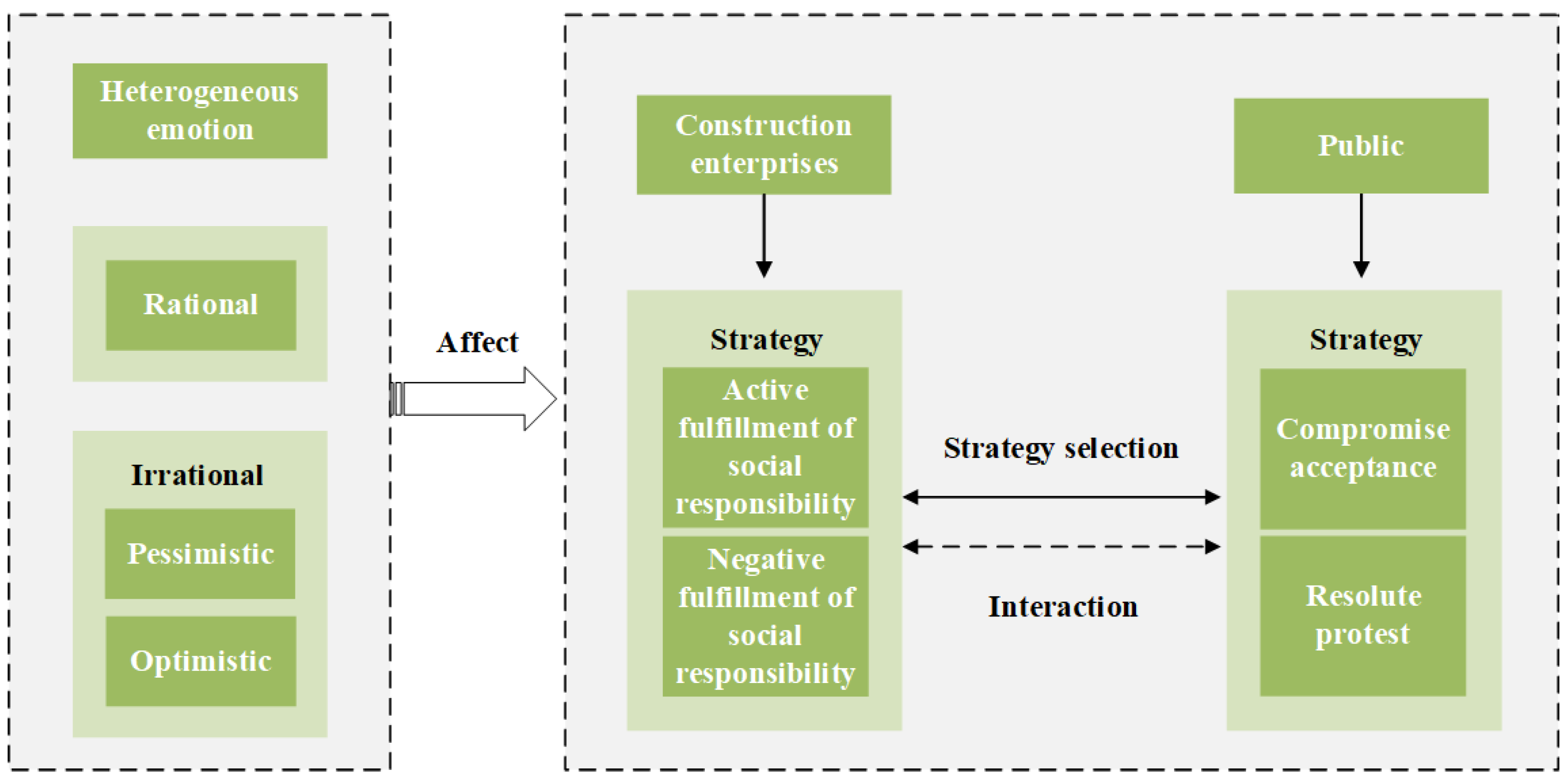

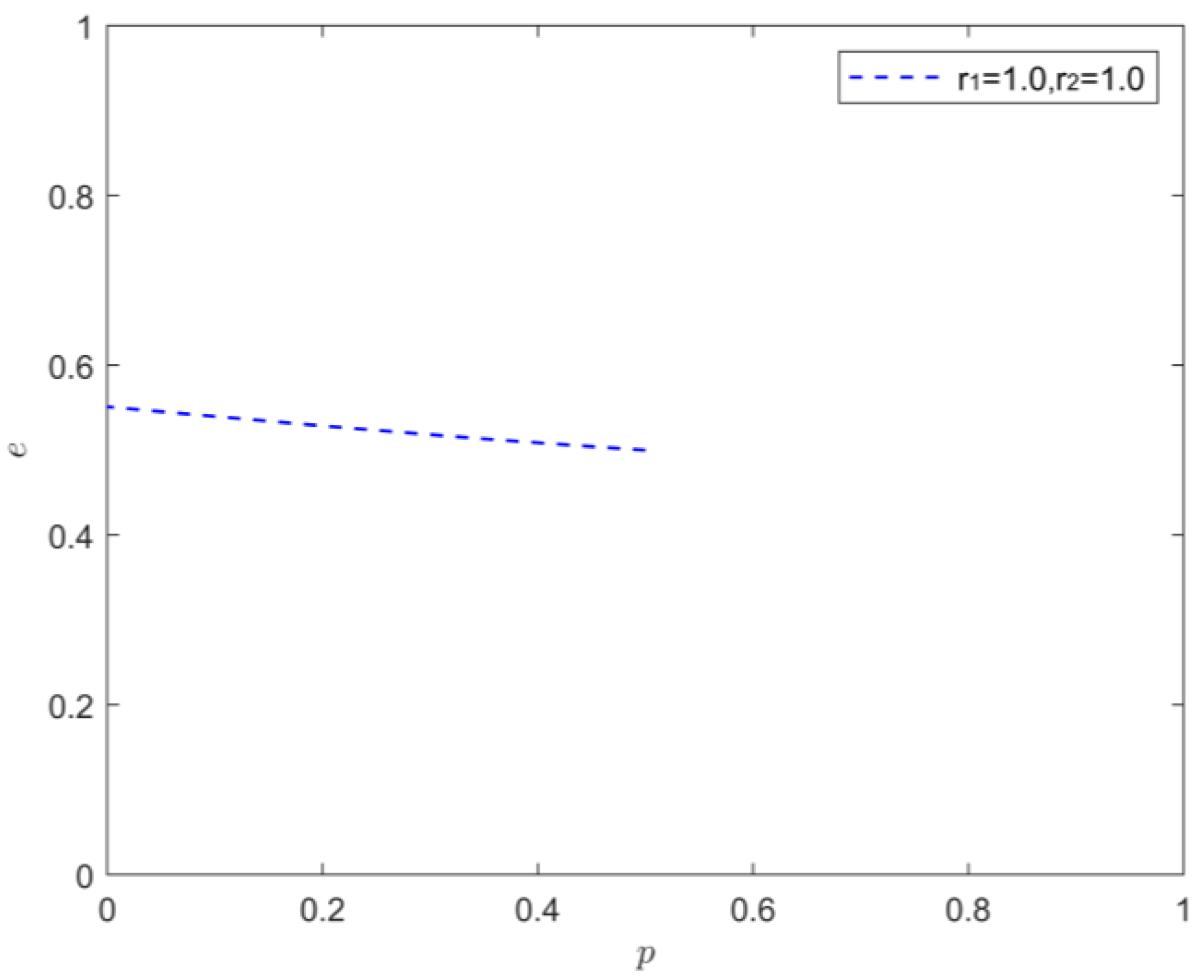

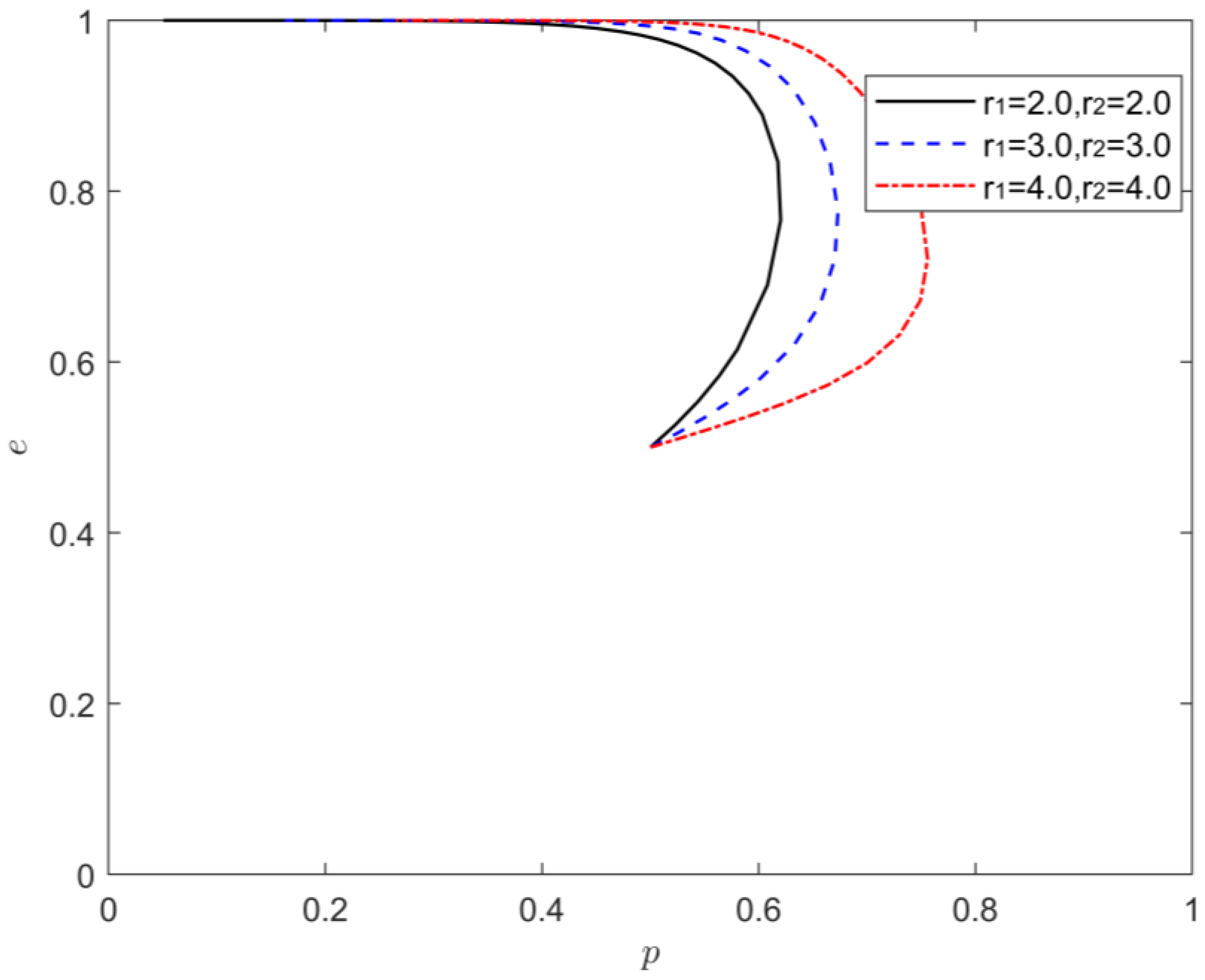
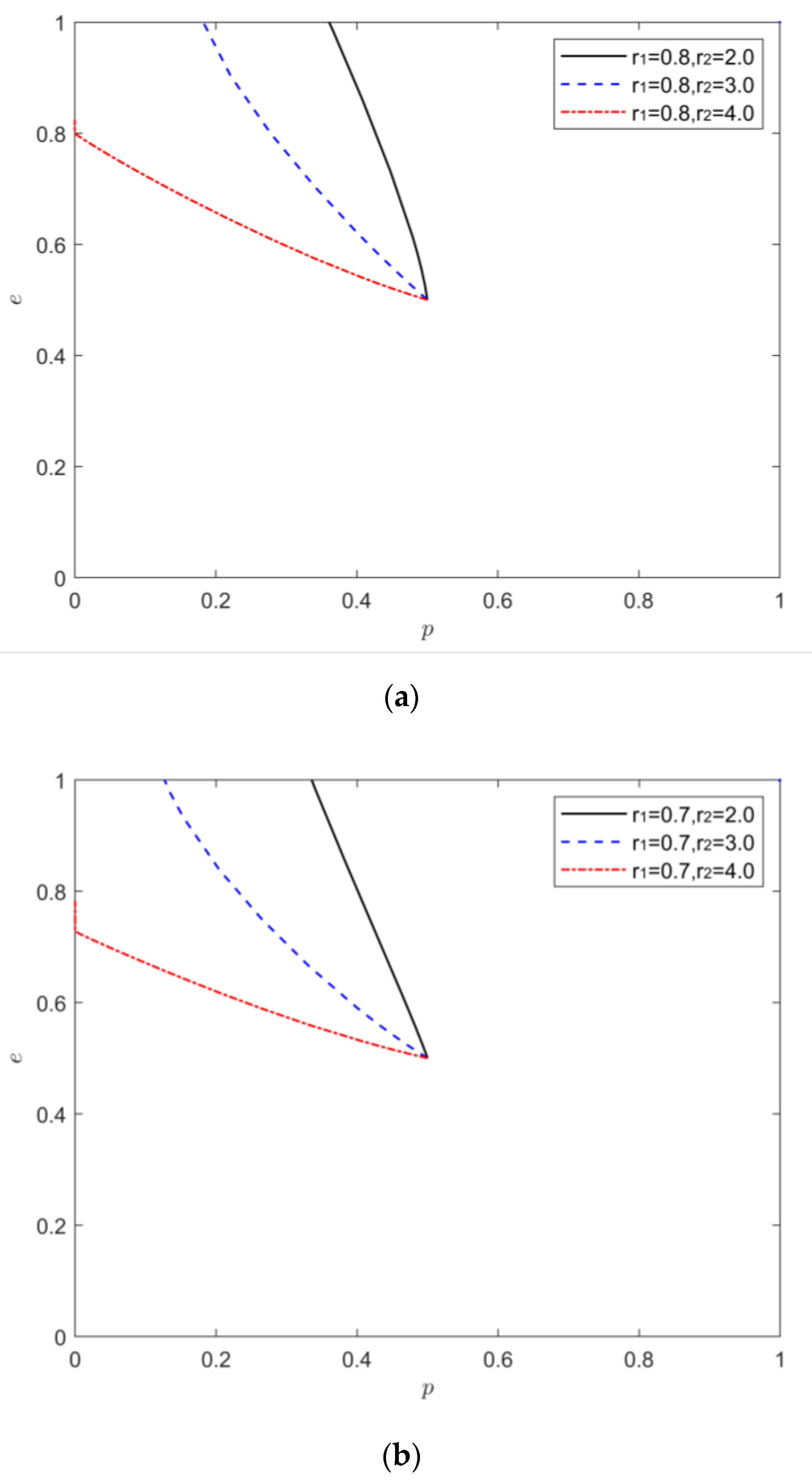

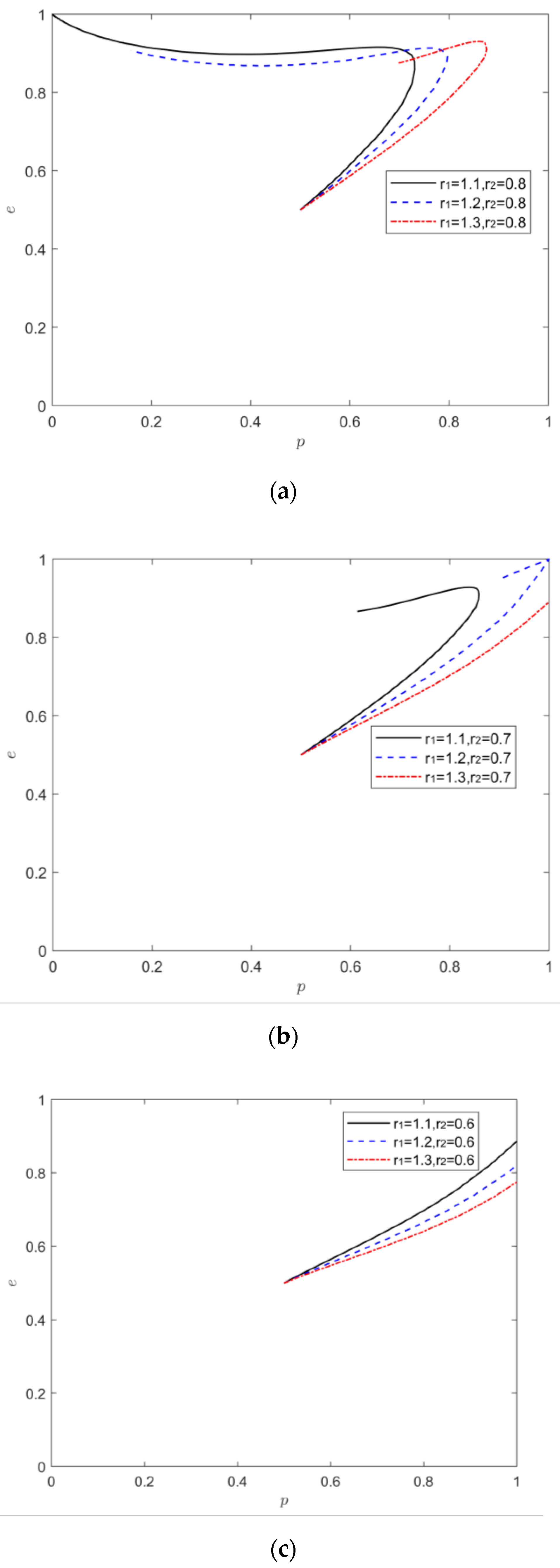
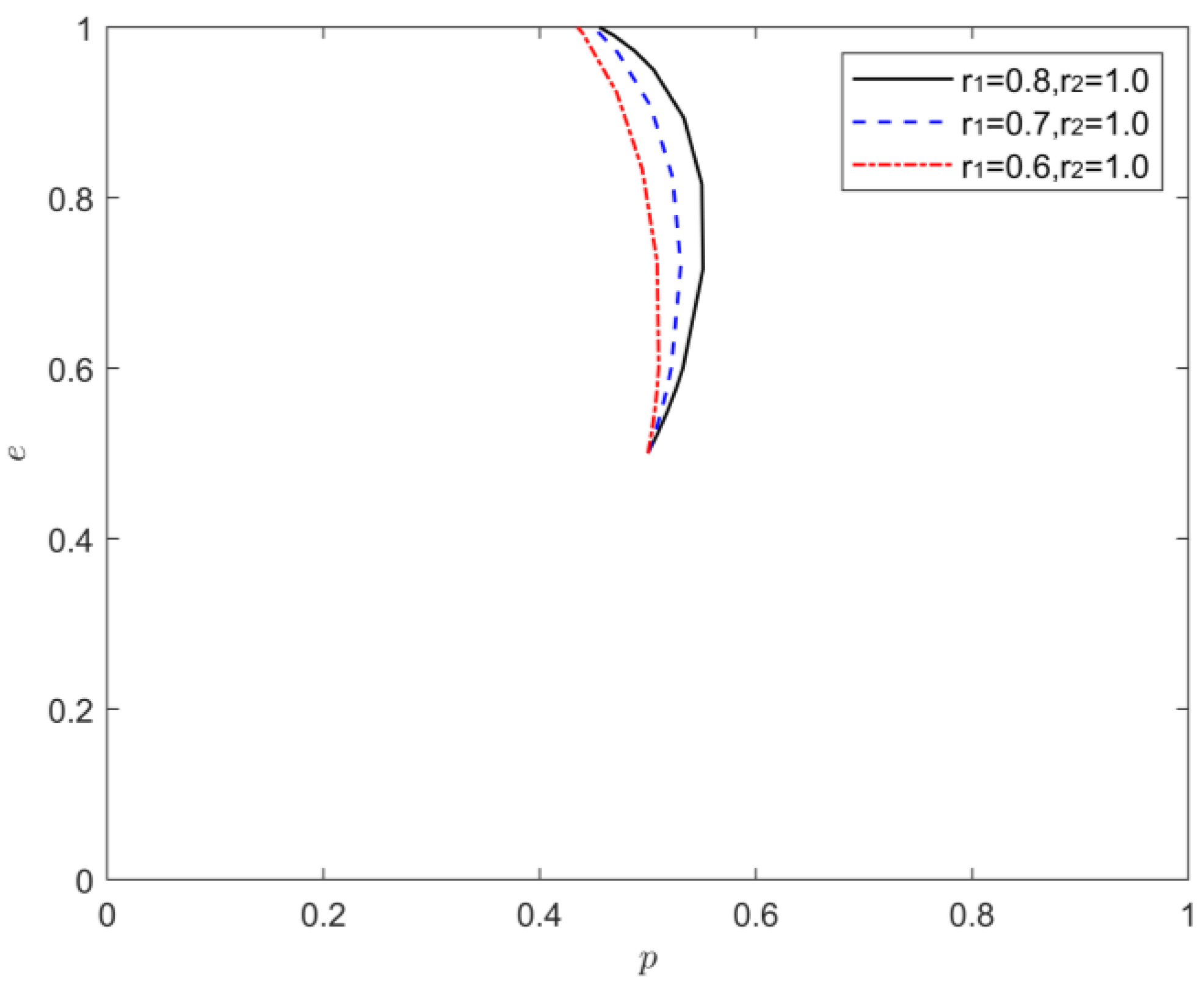
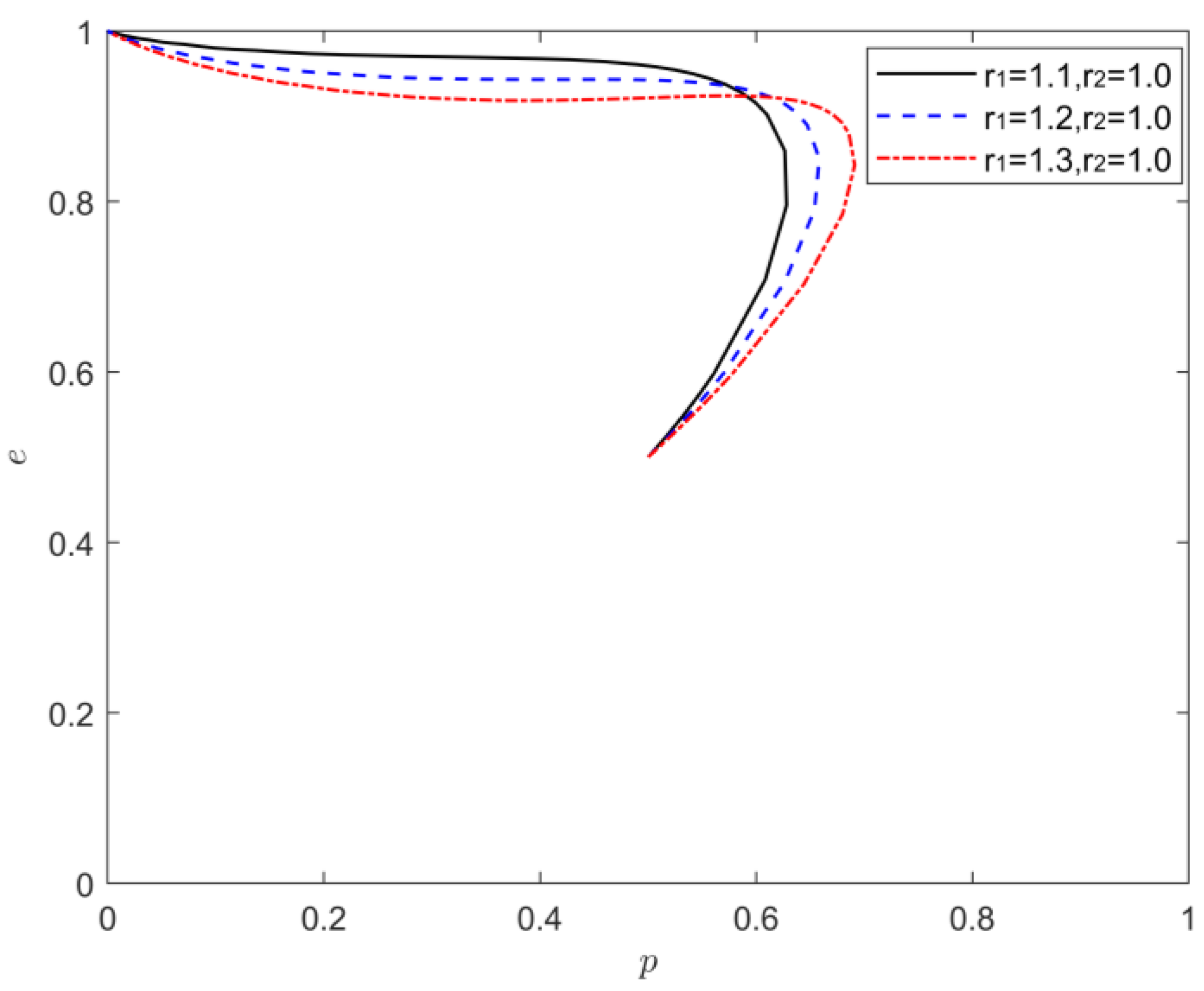

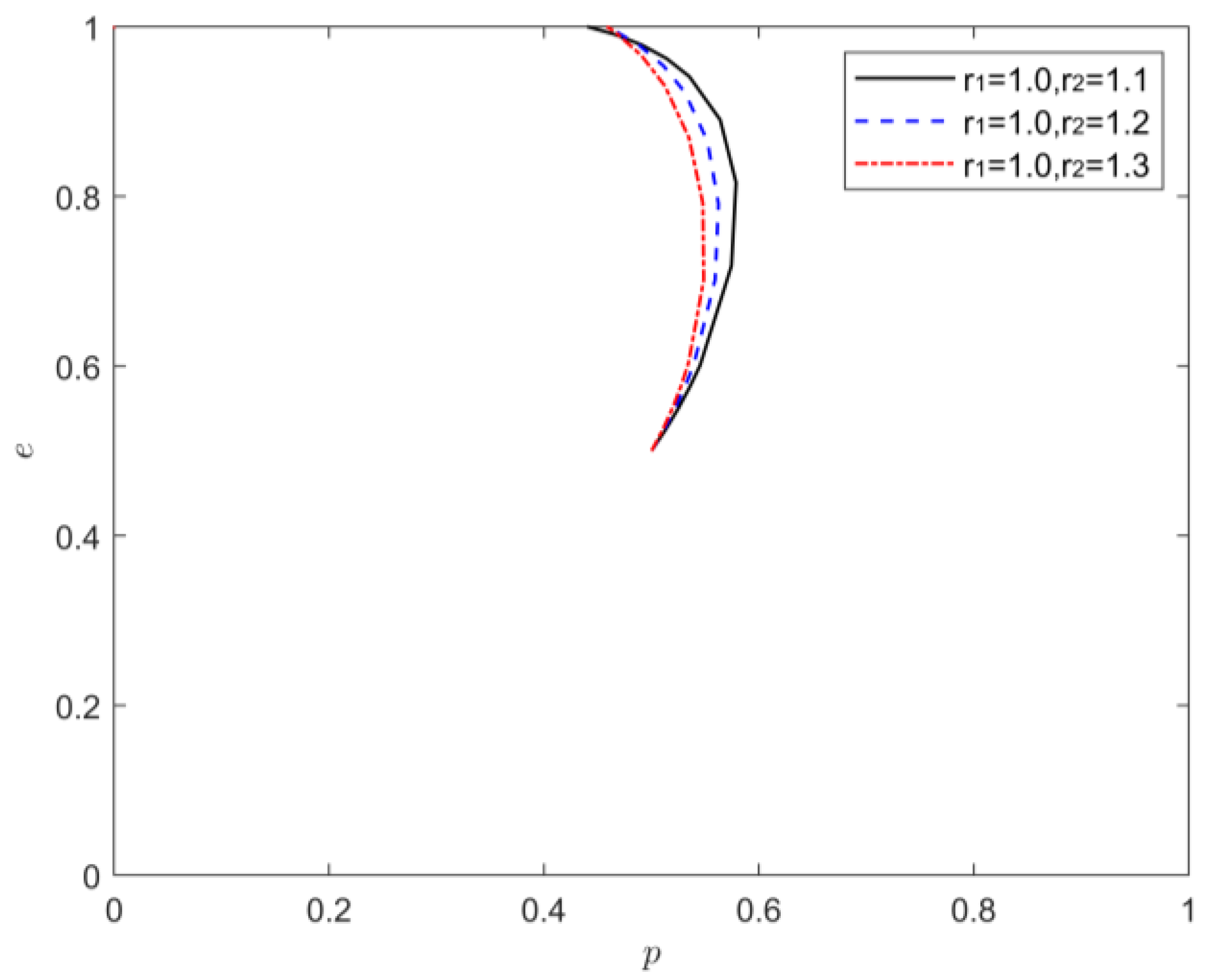
| Participation | The Public | ||
|---|---|---|---|
| Construction enterprises | Active fulfillment of social responsibility | ||
| Negative fulfillment of social responsibility | |||
| Parameter | Meaning |
|---|---|
| Probability of construction enterprises actively fulfilling their social responsibility | |
| Probability of public compromise acceptance | |
| Cost of actively fulfilling social responsibility in construction enterprises | |
| Cost of resolute public protest | |
| Positive externalities arising from the active fulfillment of social responsibility by construction enterprises | |
| Negative externalities arising from the negative fulfillment of social responsibility by construction enterprises | |
| Basic benefits of construction enterprises | |
| Basic benefits of the public | |
| Economic damage to construction enterprises as a result of resolute public protest | |
| Reputational damage to construction enterprises as a result of resolute public protest | |
| Incentives for enterprises without collective protest | |
| Compensation for public compromise acceptance by construction enterprises | |
| The proceeds of resolute public protest | |
| Emotional intensity of construction enterprises | |
| Emotional intensity of the public |
| Construction Enterprises Utility | Probability | Rank Position | Decision Weight |
|---|---|---|---|
| The Public Utility | Probability | Rank Position | Decision Weight |
|---|---|---|---|
| Balancing Point | Stability | ||||||
|---|---|---|---|---|---|---|---|
| - | × | Saddle point | |||||
| + | - | Stable | |||||
| - | × | Saddle point | |||||
| + | - | Stable | |||||
| × | × | Saddle point |
| Balancing Point | Stability | ||||||
|---|---|---|---|---|---|---|---|
| Instability | |||||||
| - | Instability | ||||||
| Instability | |||||||
| × | × | Saddle point | |||||
| Stability depends on specific values and emotional intensity. | |||||||
| Balancing Point | Stability | ||||||
|---|---|---|---|---|---|---|---|
| + | Instability | ||||||
| - | Instability | ||||||
| + | Instability | ||||||
| × | × | Saddle point | |||||
| Stability depends on specific values and emotional intensity. | |||||||
| Balancing Point | Stability | ||||||
|---|---|---|---|---|---|---|---|
| + | Instability | ||||||
| × | × | Saddle point | |||||
| - | Instability | ||||||
| × | × | Saddle point | |||||
| Stability depends on specific values and emotional intensity | |||||||
| Parameter | ||||||||
| Initial value | 0.5 | 0.5 | 1.5 | 1 | 1 | 1 | 1.3 | 1 |
| Parameter | ||||||||
| Initial value | 1.6 | 1.6 | 1 | 1.1 | 1 | 1 | 1 |
Publisher’s Note: MDPI stays neutral with regard to jurisdictional claims in published maps and institutional affiliations. |
© 2022 by the authors. Licensee MDPI, Basel, Switzerland. This article is an open access article distributed under the terms and conditions of the Creative Commons Attribution (CC BY) license (https://creativecommons.org/licenses/by/4.0/).
Share and Cite
Dang, X.; Wang, S.; Deng, X.; Zhang, Z.; Zhang, N.; Mao, H. How Does Public Sentiment Affect the Socially Responsible Behavior of Construction Enterprises? Processes 2022, 10, 2403. https://doi.org/10.3390/pr10112403
Dang X, Wang S, Deng X, Zhang Z, Zhang N, Mao H. How Does Public Sentiment Affect the Socially Responsible Behavior of Construction Enterprises? Processes. 2022; 10(11):2403. https://doi.org/10.3390/pr10112403
Chicago/Turabian StyleDang, Xiaoxu, Shihui Wang, Xiaopeng Deng, Ziming Zhang, Na Zhang, and Hongtao Mao. 2022. "How Does Public Sentiment Affect the Socially Responsible Behavior of Construction Enterprises?" Processes 10, no. 11: 2403. https://doi.org/10.3390/pr10112403
APA StyleDang, X., Wang, S., Deng, X., Zhang, Z., Zhang, N., & Mao, H. (2022). How Does Public Sentiment Affect the Socially Responsible Behavior of Construction Enterprises? Processes, 10(11), 2403. https://doi.org/10.3390/pr10112403







